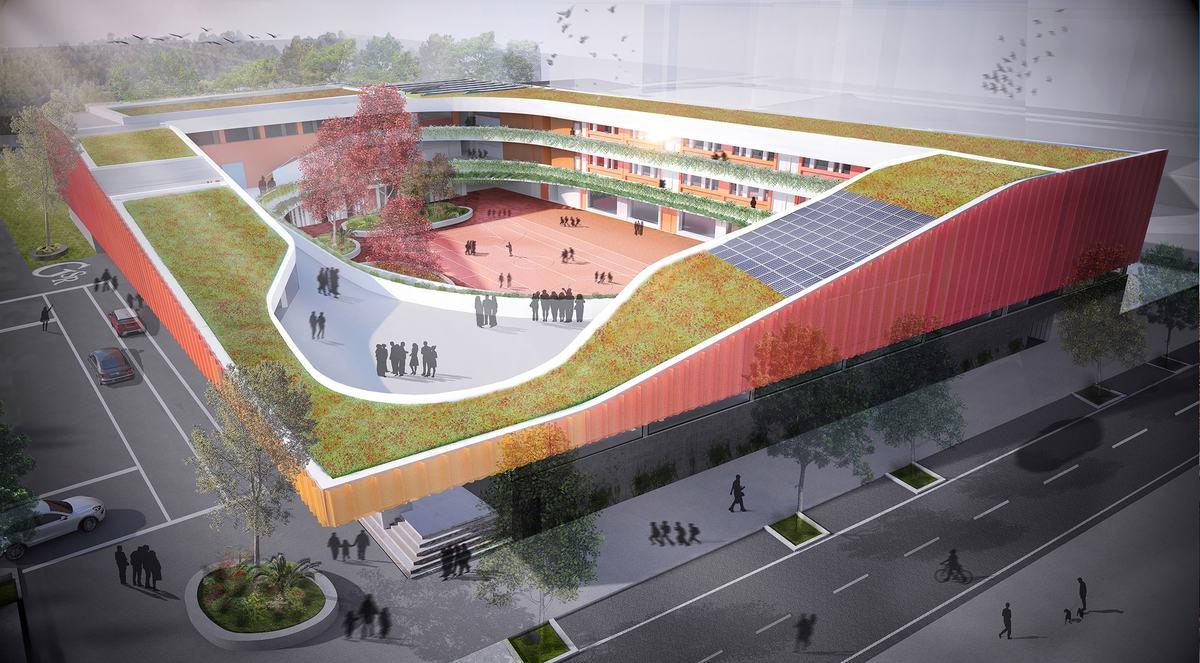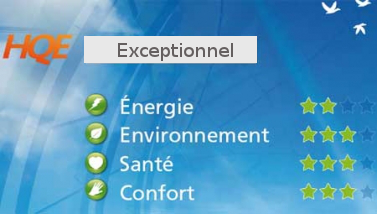Kindergarten and elementary school AUDA ANFA
Last modified by the author on 18/06/2018 - 16:34
New Construction
-
Primary energy need
401.63 kWhep/m2.an
(Calculation method : Other )
It is a school building in R + 2, on a total useful surface of 4930 m², structured as follows:
- Kindergarten located in the DRC for reasons of access facilities for small, kindergarten is organized around a courtyard.
- Elementary is organized on 2 levels, on floors +1 and +2, classes are organized in an L shape, overlooking a suspended courtyard above the kindergarten.
- Shared premises: Shared functions (canteen, multipurpose room ...) are arranged on the ground floor overlooking a green area.
- In the basement is the parking (1389 m²) and the technical rooms and delivery.
- The indoor pool is located in the DRC with filtered access through the locker room. The level of the pool is -60cm from the threshold level to obtain an optimal height and a proportional space. The pool is illuminated on the entire periphery by a high glass banner to limit visibility from the outside. Some slits also illuminate the space from the Southwest facade hidden by a wall of green fence.
- The Catering and General Services Division: Its location makes it possible to be at the heart of the flows for better accessibility to all users, and to be at the same time backed by the service area, whose location is in the basement and whose operation is completely independent. Access to service vehicles inside the establishment is thus limited. The space also has a terrace overlooking the green outdoor area, creating a pleasant extra space for students
The project is based on a principle of superposition of two courses. This central children's outdoor space is surrounded by three identifiable entities: the kindergarten, the elementary school, and the shared functions.
These entities fit together with continuity and fluidity Access to kindergarten and elementary school is done independently, by two separate entries. The shared functions (Catering, Indoor Pool, Multipurpose Room), are superimposed on the southwest side of the projects, overlooking a green space, and are easily accessible by everyone on the ground floor and R + 1.
The main entrance of the establishment is through a SAS It is a place of waiting and gathering for parents. For this purpose, it includes a large gardener, and drawing a planted and shaded boundary between public and student flows ...
See more details about this project
http://www.gsr.ac.ma/fr/Data reliability
3rd part certified
Contractor
Construction Manager
Stakeholders
Assistance to the Contracting Authority
OGER INTERNATIONAL
05 22 42 02 00
http://www.ogermaroc.telecontact.ma/MASTER
Assistance to the Contracting Authority
Bureau Veritas Maroc
+ 212 5 22 543 540
http://www.bureauveritas.ma/Accompaniment to the implementation of the HQE approach
Company
TRAMCO
05377-76090
Company
WATTELEC
05226-72343
http://www.wattelec.com/Company
POLYSOL
+212 522 305 246
Company
EURAFRIQUE
+212 661 441 821
Company
ABH
Other consultancy agency
CASA VIGILANCE
05 22 39 13 01
Company
GAOUZI
05228-02274
Owner approach of sustainability
The school group the residence has placed the social and sustainable development issues among its priorities at all stages of its project and thus wishes to promote environmental quality in Morocco in consideration of the strengths and constraints of each site.
The construction project is part of a global quality approach with particular concern for architectural integration and the taking into account of environmental parameters.
For this reason the GSR wants to register its project in a process of certification high environmental quality, cetecertification aims to ensure the environmental consistency of the actions conducted along the development of our project.
Architectural description
The project is based on a principle of overlapping two courses. This central outdoor space reserved for children is surrounded by three identifiable entities: the nursery school, the elementary school, and the shared functions. These entities fit together seamlessly and seamlessly. Access to kindergarten and elementary school is done independently by two separate entries. The shared functions (Restoration, swimming pool, multipurpose room), are superimposed on the southwest side of the projects, giving on a green space, and are easily accessible by everyone on the ground floor and R + 1.In the basement are parking, technical rooms and delivery.The main entrance of the establishment is through a SAS It is a place of waiting and gathering for parents. For this purpose, it includes a large planter, and drawing a planted and shaded boundary between public and student flows.KindergartenAt independent access, parents accompany children to their classroom. Located in the DRC for reasons of access for the little ones, it is organized around a courtyard. This protected space gives a feeling of protection, while bringing light to the classrooms without being disturbed by the noise of the traffic. It also has a new motor room generously open to the courtyard for outdoor activities.Elementary schoolThe elementary is organized on 2 levels, on floors +1 and +2.Classes are organized L-shaped, overlooking a suspended courtyard above the kindergarten.This interesting position creates a distance from the public space, while providing all the safety devices necessary for the safety of children.This device allows permanent visual contact between the nursery school and the elementary school, while keeping these two entities at a distance. The administration:Located on the ground floor, its location allows proximity and visibility from the entrance and within the establishment itself. It also has secondary access from the elementary courtyard on the upper floor to control the activity of all students during the day.The administration is also near the premises of the teachers, to whom it is provided a quiet space in R + 2 with a terrace is located in the grip of the green roof. The indoor poolIt is also located in the DRC with filtered access through the locker rooms. The level of the pool is -60cm from the threshold level to obtain an optimal height and a proportional space.The pool is illuminated on the entire periphery by a high glass banner to limit visibility from the outside. Some slits also illuminate the space from the south-west facade hidden by a wall planted fence.The Food and General Services DivisionIts location makes it possible to be at the heart of the flows for better accessibility to all users, and to be at the same timeadded to the service area, the location of which is in the basement and the operation of which is completely independent .Access to service vehicles within the establishment is thus limited.The dining area also has a terrace overlooking the green outdoor area, allowing to create a pleasant extra space for studentsLibrary, Documentation CenterFinally, the Documentation Center is located in R + 2 at the end of the circuit.This allows to reduce as much as possible the density of daily flows at the furthest point from the entrance. It also makes it possible to create an isolated space, far away from pupils and noise from the circulations, thus offering a calm working area.The Polyvalent Room:The multipurpose room is fully glazed in the lower part for optimal and controlled lighting. In addition, it benefits from a generous sunscreen through a double skin on the exterior facade, and a generous coverage on the facade overlooking the courtyard.The room has on the one hand, a stage and a back stage space, and on the other, changing rooms that are directly accessible from the elementary school grounds, sometimes the auditorium, sometimes the gymnasium, its generous dimensions and the installation of telescopic steps can be adapted as needed.
If you had to do it again?
The integration of night ventilation for classes.
Energy consumption
- 401,63 kWhep/m2.an
- 648,14 kWhep/m2.an
- 126,82 kWhef/m2.an
Envelope performance
- 1,03
Systems
- Others
- Solar Thermal
- Fan coil
- VRV Syst. (Variable refrigerant Volume)
- Double flow heat exchanger
- Solar photovoltaic
- Solar Thermal
GHG emissions
- 218,73 KgCO2/m2/an
- 260,71 KgCO2 /m2
- 50,00 an(s)
Life Cycle Analysis
Product
ROCKFON - EKLA - 60x60
rockfon
http://www.rockfon.frManagement / Others
Slabs Rock wool acoustic panel
Visible: painted white veil (structured finish)
Back side: anti-veil
Product Validated and accepted by the acoustician, the AMO HQE and the MOE,
THERMATEX AQUATEC 600/600/19 mm
knaufamf
https://www.knaufamf.com/fr/Finishing work / flooring
Plafond Cuisine THERMATEX AQUATEC 600/600/19 mm
Accepted
Urban environment
At the site level of construction of the school AUDA: Presence of the bus lines: 59 - 7 - 16 - 100. With an average proximity of 1.5 km and an average frequency of these lines going from 10 min 45 min.
Presence of ANFAparc tram stations very close to the site (less than 4 min walk), thus the HAYAndia station.
These connections have been valued by a correspondence with other transport lines and accessible and which are close.
- A first correspondence with BEAUSEJOUR station in 10 min
-A second correspondence between Anfaparc station and financial center in 11 min
Building Environmental Quality
- indoor air quality and health
- works (including waste management)
- acoustics
- comfort (visual, olfactive, thermal)
- waste management (related to activity)
- water management
- energy efficiency
- renewable energies
- mobility
- products and materials
Reasons for participating in the competition(s)
La conception du bâtiment répond largement aux principes de la conception bioclimatique : Cette école constitue un bâtiment remarquable visible par toutes ses façades et aussi par sa toiture végétalisée.
Ce design va permettre à l'école d'être parmi les bâtiments emblématiques et un repère architectural fort au niveau du quartier ANFA, le bâtiment est à la fois convivial et protecteur, tourné vers la cour intérieure pour assurer l'intimité des enfants,
Le bâtiment est animé de l'extérieur par un jeu d'ombre et lumière avec brises soleil en verre sérigraphié, une grande façade mosaïque abrite l'entrée de l'école et avec un design en spirale.
La végétation reste parmi les atouts de ce projet tout en choisissant des essences indigènes, adaptés au climat local et à faible potentiel allergène (selon le RNSA).
Les matériaux utilisés sont écologiques dont les caractéristiques sont vérifiées, les produits gros œuvres sont 100 % locales et disposent d’une analyse de cycle de vie, les produits second œuvres sont en général des produits importés avec des caractéristiques environnementales (Impacts environnementales) et sanitaires (émission COV, caractéristiques antifongiques et bactéricides) répondant aux exigences de la haute qualité environnementale.
Le chantier du projet a donné l’exemple du chantier à faible nuisance par la mise en place d’un ensemble d’actions de suivi environnementale grâce à la veille de l’AMO HQE et responsable de chantier vert, ainsi qu’à l’implication des entreprises des travaux, la volonté environnementale du MOA a été traduite sur chantier.
D'après l’étude de faisabilité des énergies renouvelables sur site, l'énergie solaire reste la mieux adaptée au projet, et l'exploitation de cette source d'énergie gratuite est concrétisée par La mise en place des capteurs solaires thermiques permettant d'après de couvrir plus de 40% des besoins en Eau chaude sanitaire de la piscine, ainsi la mise en place des capteurs solaires photovoltaïques a permis de couvrir au moins 10 % des besoins en électricité de l’école.
En plus l’intégration des EnR, le bâtiment fait recours pour répondre aux besoins en énergie et eau à des systèmes efficaces.
Le chauffage et la climatisation des différentes salles d’enseignement se fait par un système à débit variable afin de limiter la consommation en fonction de la demande, ainsi qu’une centrale de traitement d’air avec récupération de chaleur.
L’éclairage général du bâtiment est assuré par des luminaires en LED avec des très basses consommations par rapport à la référence (ASHRAE 2010), des détecteurs de présence sont mis en place dans tous les locaux sanitaires ainsi que les escaliers.
Les ascenseurs sont de type économes équipés des variateurs de vitesse.
En général l’efficacité énergétique a été bien intégrée dans le bâtiment non seulement par le choix des équipements mais aussi le choix d’une enveloppe performant en utilisant des matériaux répondant largement aux variations des apports et déperditions thermiques saisonnières et en mettant en place une isolation thermique convenable. Une simulation thermique dynamique prouve que le bâtiment peut atteindre des gains en énergie primaire de plus de 35 % par rapport à la référence locale (RTCM) et internationale (ASHRAE).
Le besoin en eau ne dépasse pas le besoin de référence (CSTB), une cuve de 250 m3 de récupération des eaux pluviales a été mise en place au niveau du sous-sol pour répondre aux besoins en arrosage, en plus, un coefficient d’imperméabilisation globale du bâtiment déplace les 70 % avec un volume annuel total infiltré de 923 m3, un recyclage 1232 m3 et seulement 111 m3 annuellement rejeté au réseau, par conséquence le bâtiment favorise le cycle naturel de l’eau au niveau de la zone d’ANFA.
Et pour suivre et rationaliser la consommation d’énergie et eau au cours de l’exploitation de l’école, des compteurs d’énergie (pour le CVC, éclairage et ECS), ainsi que des compteurs de l’eau (pour chaque poste principal) ont été mis en place.
Le confort des occupants (élèves, corps professoral, administratif, visiteurs…) demeure une préoccupation essentielle pour le maitre d’ouvrage, un confort visuel et une meilleur exploitation de la lumière du jour ont été bien prouvé par la conception du bâtiment, par le choix des matériaux reflétant et un taux de vitrage (double vitrage) soutenu, un bon confort hygrothermique est atteignable via l’équipement CVC sophistiqué utilisant des moyens de contrôle et de pilotage centralisé est assuré par des thermostats d’ambiance dans tous les locaux à climatiser et d’un détecteur de CO2 pour chaque salle d’étude.
Un acousticien a été intégré dans le projet pendant les phases conception et réalisations, et des dispositions techniques et architecturales ont été mis en place pour atteindre d’un niveau d’isolement acoustique standardisé, un niveau de bruit des équipements, un niveau de bruit de choc …, conforment aux exigences en vigueur dans le cadre de la démarche haute qualité environnementale pour ce projet.
La santé des occupants était une priorité du maitre d’ouvrage, et la présence d’un AMO HQE sur le projet a facilité l’atteinte des objectifs sanitaires du projet.
L’atteinte bonne qualité de l’air à l’intérieur du bâtiment en utilisant des débits d’air qui sont conformes à la norme EN 15 251 et la norme ASHRAE 2010, et la configuration des filtres aérauliques (G4, F7, F9…) est bien justifiée performante.
Les espaces de restauration sont dotés des revêtement bactéricide et antifongique et pour les autres espaces les peintures choisis sont à faible émission de COV (A+), ces matériaux sont facilement nettoyables.
Le projet a été certifié Haute qualité environnementale – phase conception avec un niveau EXCEPTIONNEL, et il est prévu qu’il soit certifié HQE exceptionnel – phase exécution, et il a toutes les chances pour qu’il soit candidat gagnant du titre « Green Award 2018 ».
Building candidate in the category

Energy & Hot Climates

Health & Comfort












